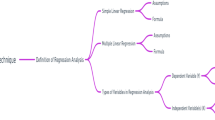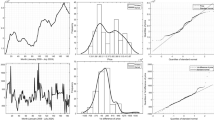Abstract
The paper presents methods of modeling the real estate market using trend functions reflecting changes in real estate prices over time. Real estate transaction prices that are used to create data-driven valuation models must be updated in line with the trend of their change. The primary purpose of the first part of the study was to examine the extent to which splines are suitable for the trend function compared to polynomials of the degree from 1 to 6. In turn, the second part was to compare the performance of prediction models built on the basis of updated data with various trend functions: splines and polynomials. The experiments were conducted using real data on purchase and sale transactions of residential premises concluded in one of the Polish cities. Four machine learning algorithms implemented in the Python environment were used to generate property valuation models. Statistical analysis of the results was carried out using non-parametric Friedman and Wilcoxon tests. The study showed the usefulness of applying splines to model trend functions.
Access this chapter
Tax calculation will be finalised at checkout
Purchases are for personal use only
Similar content being viewed by others
References
Lasota, T., Sawiłow, E., Trawiński, B., Roman, M., Marczuk, P., Popowicz, P.: A method for merging similar zones to improve intelligent models for real estate appraisal. In: Nguyen, N.T., Trawiński, B., Kosala, R. (eds.) ACIIDS 2015, Part I. LNCS (LNAI), vol. 9011, pp. 472–483. Springer, Cham (2015). https://doi.org/10.1007/978-3-319-15702-3_46
Lasota, T., et al.: Enhancing intelligent property valuation models by merging similar cadastral regions of a municipality. In: Núñez, M., Nguyen, N.T., Camacho, D., Trawiński, B. (eds.) ICCCI 2015, Part II. LNCS (LNAI), vol. 9330, pp. 566–577. Springer, Cham (2015). https://doi.org/10.1007/978-3-319-24306-1_55
Kontrimas, V., Verikas, A.: The mass appraisal of the real estate by computational intelligence. Appl. Soft Comput. 11(1), 443–448 (2011). https://doi.org/10.1016/j.asoc.2009.12.003
Zurada, J., Levitan, A.S., Guan, J.: A comparison of regression and artificial intelligence methods in a mass appraisal context. J. Real Estate Res. 33(3), 349–388 (2011)
Peterson, S., Flangan, A.B.: Neural network hedonic pricing models in mass real estate appraisal. J. Real Estate Res. 31(2), 147–164 (2009)
Narula, S.C., Wellington, J.F., Lewis, S.A.: Valuating residential real estate using parametric programming. Eur. J. Oper. Res. 217, 120–128 (2012)
Antipov, E.A., Pokryshevskaya, E.B.: Mass appraisal of residential apartments: an application of Random forest for valuation and a CART-based approach for model diagnostics. Expert Syst. Appl. 39, 1772–1778 (2012). https://doi.org/10.1016/j.eswa.2011.08.077
D’Amato, M.: Comparing rough set theory with multiple regression analysis as automated valuation methodologies. Int. Real Estate Rev. 10(2), 42–65 (2007)
Kusan, H., Aytekin, O., Özdemir, I.: The use of fuzzy logic in predicting house selling price. Expert Syst. Appl. 37(3), 1808–1813 (2010). https://doi.org/10.1016/j.eswa.2009.07.031
Woźniak, M., Graña, M., Corchado, E.: A survey of multiple classifier systems as hybrid systems. Inf. Fusion 16, 3–17 (2014). https://doi.org/10.1016/j.inffus.2013.04.006
Jȩdrzejowicz, J., Jȩdrzejowicz, P.: A family of GEP-induced ensemble classifiers. In: Nguyen, N.T., Kowalczyk, R., Chen, S.-M. (eds.) ICCCI 2009. LNCS (LNAI), vol. 5796, pp. 641–652. Springer, Heidelberg (2009). https://doi.org/10.1007/978-3-642-04441-0_56
Burduk, R., Baczyńska, P.: Dynamic ensemble selection using discriminant functions and normalization between class labels – approach to binary classification. In: Rutkowski, L., Korytkowski, M., Scherer, R., Tadeusiewicz, R., Zadeh, L.A., Zurada, J.M. (eds.) ICAISC 2016. LNCS (LNAI), vol. 9692, pp. 563–570. Springer, Cham (2016). https://doi.org/10.1007/978-3-319-39378-0_48
Kazienko, P., Lughofer, E., Trawiński, B.: Hybrid and ensemble methods in machine learning. J. Univ. Comput. Sci. 19(4), 457–461 (2013)
Fernández, A., López, V., José del Jesus, M., Herrera, F.: Revisiting evolutionary fuzzy systems: taxonomy, applications, new trends and challenges. Knowl.-Based Syst. 80, 109–121 (2015). https://doi.org/10.1016/j.knosys.2015.01.013
Lughofer, E., Cernuda, C., Kindermann, S., Pratama, M.: Generalized smart evolving fuzzy systems. Evol. Syst. 6(4), 269–292 (2015). https://doi.org/10.1007/s12530-015-9132-6
Lasota, T., Telec, Z., Trawiński, B., Trawiński, K.: A multi-agent system to assist with real estate appraisals using bagging ensembles. In: Nguyen, N.T., Kowalczyk, R., Chen, S.-M. (eds.) ICCCI 2009. LNCS (LNAI), vol. 5796, pp. 813–824. Springer, Heidelberg (2009). https://doi.org/10.1007/978-3-642-04441-0_71
Krzystanek, M., Lasota, T., Telec, Z., Trawiński, B.: Analysis of bagging ensembles of fuzzy models for premises valuation. In: Nguyen, N.T., Le, M.T., Świątek, J. (eds.) ACIIDS 2010. LNCS (LNAI), vol. 5991, pp. 330–339. Springer, Heidelberg (2010). https://doi.org/10.1007/978-3-642-12101-2_34
Lasota, T., Telec, Z., Trawiński, B., Trawiński, K.: Exploration of bagging ensembles comprising genetic fuzzy models to assist with real estate appraisals. In: Corchado, E., Yin, H. (eds.) IDEAL 2009. LNCS, vol. 5788, pp. 554–561. Springer, Heidelberg (2009). https://doi.org/10.1007/978-3-642-04394-9_67
Lasota, T., Telec, Z., Trawiński, G., Trawiński, B.: Empirical comparison of resampling methods using genetic fuzzy systems for a regression problem. In: Yin, H., Wang, W., Rayward-Smith, V. (eds.) IDEAL 2011. LNCS, vol. 6936, pp. 17–24. Springer, Heidelberg (2011). https://doi.org/10.1007/978-3-642-23878-9_3
Trawiński, B.: Evolutionary fuzzy system ensemble approach to model real estate market based on data stream exploration. J. Univ. Comput. Sci. 19(4), 539–562 (2013). https://doi.org/10.3217/jucs-019-04-0539
Lughofer, E., Trawiński, B., Trawiński, K., Kempa, O., Lasota, T.: On employing fuzzy modeling algorithms for the valuation of residential premises. Inf. Sci. 181, 5123–5142 (2011). https://doi.org/10.1016/j.ins.2011.07.012
Meijering, E.: A chronology of interpolation: from ancient astronomy to modern signal and image processing. Proc. IEEE 90(3), 319–342 (2002). https://doi.org/10.1109/5.993400
Piegl, L., Tiller, W.: The NURBS Book. Springer, Heidelberg (1995). https://doi.org/10.1007/978-3-642-97385-7
Runge, C.: Über empirische Funktionen und die Interpolation zwischen äquidistanten Ordinaten. Zeitschrift für Mathematik und Physik 46, 224–243 (1901). www.archive.org
Dierckx, P.: Curve and Surface Fitting with Splines. Oxford University Press, Oxford (1993)
de Boor, C.: A Practical Guide to Splines. Springer, New York (2001)
Author information
Authors and Affiliations
Corresponding author
Editor information
Editors and Affiliations
Rights and permissions
Copyright information
© 2020 Springer Nature Switzerland AG
About this paper
Cite this paper
Jarosz, M., Kutrzyński, M., Lasota, T., Piwowarczyk, M., Telec, Z., Trawiński, B. (2020). Machine Learning Models for Real Estate Appraisal Constructed Using Spline Trend Functions. In: Nguyen, N., Jearanaitanakij, K., Selamat, A., Trawiński, B., Chittayasothorn, S. (eds) Intelligent Information and Database Systems. ACIIDS 2020. Lecture Notes in Computer Science(), vol 12033. Springer, Cham. https://doi.org/10.1007/978-3-030-41964-6_55
Download citation
DOI: https://doi.org/10.1007/978-3-030-41964-6_55
Published:
Publisher Name: Springer, Cham
Print ISBN: 978-3-030-41963-9
Online ISBN: 978-3-030-41964-6
eBook Packages: Computer ScienceComputer Science (R0)




